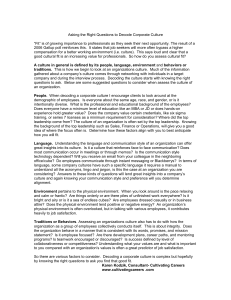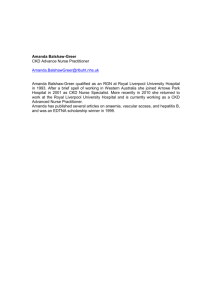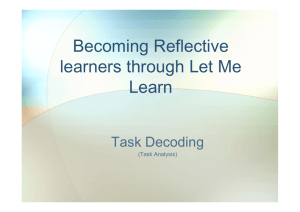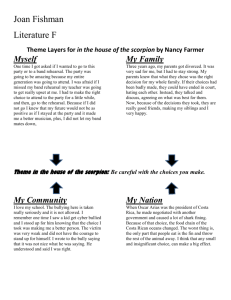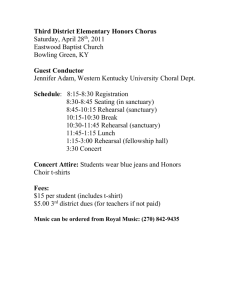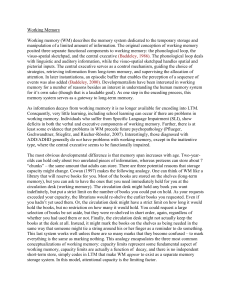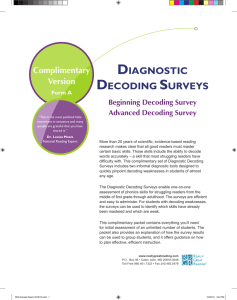Slides
advertisement
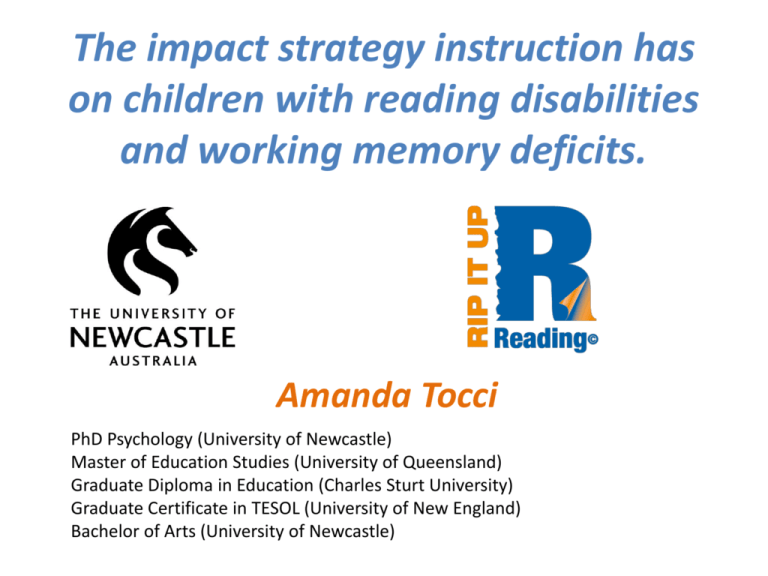
The impact strategy instruction has on children with reading disabilities and working memory deficits. Amanda Tocci PhD Psychology (University of Newcastle) Master of Education Studies (University of Queensland) Graduate Diploma in Education (Charles Sturt University) Graduate Certificate in TESOL (University of New England) Bachelor of Arts (University of Newcastle) What are the stats? • In August of 2012 there were over 24 different literacy programs in use within the NSW school system. (Ministerial Advisory Group, 2012) • There are approximately 4,495 eight year olds who are significantly challenged in reading after three years in NSW schools. (Ministerial Advisory Group, 2012) • In a report by the Australian Association for Research In Education (2006) it is noted that some reports indicated that 30% of Australian students do not reach acceptable levels of literacy (Louden et al.,2000; Marks & Ainely,1997) and for disadvantaged children the figure has been reported as high as 60% (Orr, 1994). What needs to be done? National Reading Panel (2000), National Inquiry into the Teaching of Literacy (2005) and the Rose Report (2006). Support for the use of a phonological emphasis in classroom and intervention programs. Support for explicit and systematic teaching that links the manipulation of phonemes with the associated letters. Instruction that is restricted to small groups. Instruction that is 30 minutes in duration for a session with a total programme time of more than 20 hours. Direct delivery of instruction by classroom teachers or other trained professionals rather than by paraprofessionals or through computer programmes. Instruction is most effective when taught in the first 3 years of formal schooling. Instructional strategies that match a student’s age and/or ability level. An integrated teaching approach that includes phonics, phonemic awareness, fluency, comprehension and vocabulary. HYPOTHESIS This study investigated the relationship between Baddeley & Hitch’s Working Memory Theory (1974, 1986, 1994), Cowan’s Embedded Process Theory (1988, 1995, 1999, 2001) and Barrouillet’s Time Based Resource Sharing Model (2004) in the development of a strategy based reading intervention program for children with reading disabilities. Sweller’s Cognitive Load Theory was also considered in the research. A study was conducted to investigate how strategy instruction influences reading intervention performance in a reading disabled population utilising three key working memory strategies of: • rehearsal • pace • chunking WORKING MEMORY THEORIES -store 1.5-2 seconds Rehearsal COWAN BARROUILLET BADDELEY & HITCH -Attention/time Pace -4+2 Chunking/Rehearsal READING INTERVENTION PROGRAM Research Objectives The study aimed to investigate the following quantitative questions: • 1. Will a working memory theory reading intervention program increase pseudoword, word reading and reading comprehension in a reading disabled population? • 2. What effect does a working memory theory intervention reading program have on numerical operations and maths reasoning development? • 3. What impact does a working memory theory intervention reading program have on the phonological loop and visuospatial sketchpad of working memory? Method • The research examined second and third year primary school children with a verbal working memory deficit in the bottom 25% percentile, a full scale intelligence quotient (FSIQ) >80 and a reading disability of approximately 2 years behind chronological age. • These children were assigned to 15 hours of strategy instruction emphasising the phonologic and orthographic connections in words and text-based reading. That is 30 minutes 1x per week. • The intervention reading program focussed on developing decoding strategies through rehearsal, pace and chunking of strategies taught utilising working memory theory. • The research methodology included a study of two cohorts, an intervention and control group. • The intervention group were instructed in a reading program which incorporated the key theories of Baddely & Hitch (1974, 1986, 1994), Cowan (1988, 1995, 1999, 2001) and Barrouillet (2004). The control group were instructed through current classroom based programs. Criteria • FSIQ>80 • Year 2 and Year 3 • Working Memory Deficit <25th percentile • Reading disability Intervention The program included a working memory reading program which it is was hypothesised would help children develop an understanding of the phonologic and orthographic connections in words. This occurred within an environment where distractibility components were minimized for participants. • • • • • The explicit nature of the program incorporated correct modelling, cuing, rehearsal and correction of session content. The structured nature of the program was the controlled format of each session which incorporated the key learning areas of listening, reading, writing and speaking. The systematic component of the program explored the relationship between the phonologic and orthographic in the acquisition of reading. The reading program focussed on developing grapheme-phoneme units, that is phonological recoding, the sequential translation of letters into sounds and the blending of these sounds into the spoken form of the word. It was hypothesised that by focusing on word attack skills, through the utilisation of chunks, rehearsal and pace, that participants would be given strategies to attack new words, that is their decoding ability which is proposed will transfer knowledge into long term memory and increase the reading ability of children. Reading Program ____________________________________________________________________ at at at at (1) (2) (3) (4) ____________________________________________________________________ (it) (ap) (ip) ____________________________________________________________________ at it ap ip ____________________________________________________________________ ___________________________________________________________________ cat rat hat mat ___________________________________________________________________ __________________________________________________________________ c at r at h at m at __________________________________________________________________ ___________________________________________________________________ cat rat hat mat ___________________________________________________________________ __________________________________________________________________ ____at ____at ____at ____at __________________________________________________________________ _________________________________________________________________ The fat cat sat on the fat rat on the mat. _________________________________________________________________ _________________________________________________________________ The fat cat sat on the fat rat on the mat _________________________________________________________________ _________________________________________________________________ Results Major findings of the study indicated that: • A causal relationship with the Intervention Reading Program and pseudoword decoding ability p<0.000. Effect size of 0.60. • A significant association between a Working Memory Theory based reading intervention program and the measures of pseudoword decoding, reading comprehension and maths reasoning. • No significant association in numerical operations. • No statistically significant difference between the two treatment groups to show that the Working Memory Theory reading intervention program had any positive or negative influence on the phonological loop or visuospatial sketchpad of working memory. Recommendations From the research project the following recommendations have been highlighted: • The recognition by the Department of Education of the importance of working memory theory in learning. • The recognition by the Department of Education of the need for working memory deficits to attract disability funding. • The recognition by the Department of Education of the need for children with working memory deficits to be given provisions in classrooms, assignments and in testing conditions. • A greater focus on the psychology of learning, specifically working memory theory in undergraduate bachelor of teaching/bachelor of education degrees across the duration of the degree. • Stage 1 identification by teachers of children suspected of having deficits in working memory. • The use of a research based intervention reading program that focuses specifically on the development of decoding skills. • The use of a research based intervention reading program that focuses specifically on developing transference skills after decoding development. www.ripitupreading.com.au The World’s First Working Memory Intervention Reading Program INSPIRATIONAL PROGRAM The two days were thoroughly enjoyable thanks to Amanda and her infectious enthusiasm and laughter. I think the highlight of our time spent covering the program and putting it into practise was the enthusiasm of the students as they were ripping up those pages – it put a smile on everyone’s face. Sarah Voll LaST Teacher, Hilltop Road Public School EVERY SCHOOL SHOULD HAVE THIS PROGRAM! The RIP IT UP Reading program is vital to developing the fundamental skill of decoding for children with working memory deficit. We have been up and running with the program for only 4 weeks, and I am already seeing improvements, especially in students confidence. This program is stripped right back, it is so simple, and yet so bloody fantastic. As a Learning and Support Teacher, I have been frustrated for years with how hard I work and how much I try to learn about assisting kids with learning difficulties, they move forward and then suddenly it’s all gone again. We CAN help these kids, we CAN get them reading, we CAN make that difference. To have a program written with working memory theory at its core is clearly the key to success and I am so proud to be a part of it. Thank you Amanda for sharing your amazing brain with the world. RIP IT UP IS GREAT! • Student decoding and self correcting skills are the most obvious areas of improvement. The language selection in the passages makes them attend better to every word. • I like the pace, the ease in making corrections, students do not get frustrated or bored and are feeling a lot of success, especially with how effectively they are reading the passages by the end of a level. Rarely need to help with any decoding at the passage level. I love the multi sensory activities (good balance of reading and writing) and variety to keep kids engaged. Mandy Henson LaSt Charlton Christian College YOU WILL NOT BE DISAPPOINTED Due to the practical element of the training, many teachers commented that Amanda’s enthusiastic style was the reason they now have a clearer understanding of students, in their class, and how these students tap into their working memory. It certainly made teachers aware that there are a number of students who require to be taught, the same skill, repeatedly more times than had previously. I would recommend that any educator who has the opportunity to attend Amanda’s presentation, with the intention of introducing this program onto your school, to do so as they will not be disappointed. Lisa Cavanagh (STLaN) Eagleby South State School Thank you for your time. Amanda Tocci Literacy, Learning & Working Memory Specialist Researched Reading Intervention based on Working Memory Theory For further information on the RIP IT UP Reading Program or Amanda Tocci’s research please email contact@auslit.com.au

